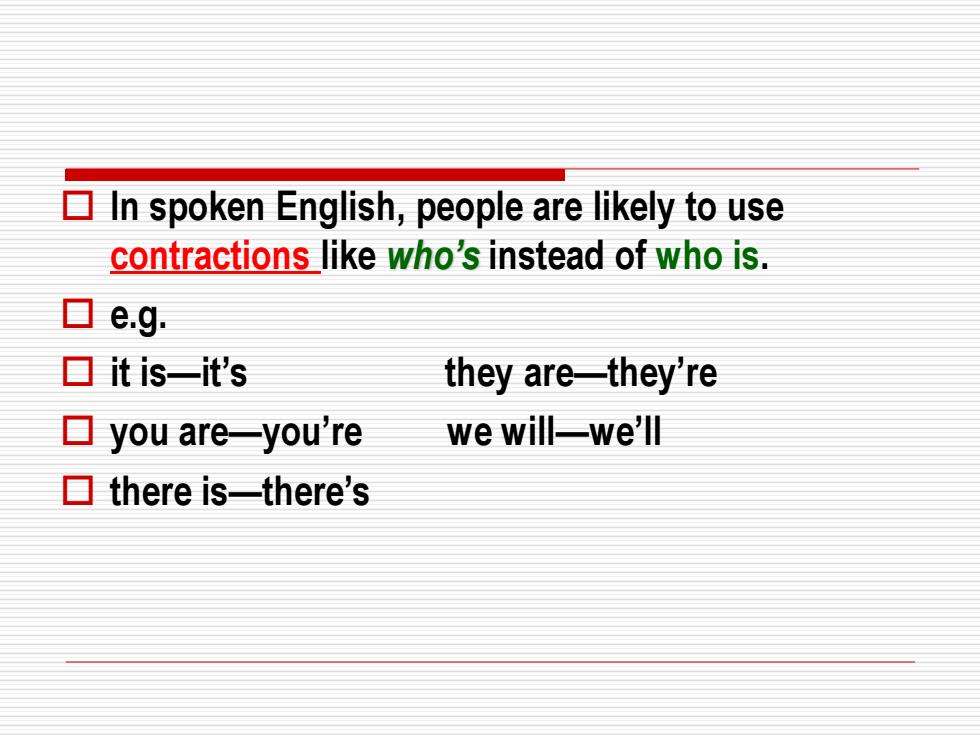
器 Unit One Listening Course (1)
Unit One Listening Course (1)

Section One Tactics for Listening
Section One Tactics for Listening

Training Focus: ▣1.Phonetics: Weak forms,link-ups and contractions ▣2.Note-taking Selecting Key Words
Training Focus: 1. Phonetics: Weak forms, link-ups and contractions 2. Note-taking Selecting Key Words

Part l:Phonetics Some words are read in strong forms while some others are read in weak forms.In a sentence, nouns,verbs,adjectives and adverbs are read louder than words like pronouns,prepositions, connections etc. The vowel sounds in these words are reduced to weak forms. e.g.for /f:/-/fo has /haez/-/hezl小ez
Part I: Phonetics Some words are read in strong forms while some others are read in weak forms. In a sentence, nouns, verbs, adjectives and adverbs are read louder than words like pronouns, prepositions, connections etc. The vowel sounds in these words are reduced to weak forms. e.g. for /fכ/ - /:fə / has /hæ z/-/həz/-/əz/

In spoken English,people are likely to use contractions like who's instead of who is. ▣e.g. ▣itis-it's they are-they're ▣you areyou're we will-we'l‖ ▣there is-there's
In spoken English, people are likely to use contractions like who’s instead of who is. e.g. it is—it’s they are—they’re you are—you’re we will—we’ll there is—there’s

In spoken English,link-ups often occur,too. ▣e.g.all over the world leuve/ ▣ What can I do for you? /wot kaenai du fe ju/
In spoken English, link-ups often occur, too. e.g. all over the world / כləuvə / What can I do for you? /wכt kæ nai du fə ju/

Key to the exercise: ▣1.for you 2.Who's ▣3 know him 4.That's ▣5.you'll be 6.When's ▣7.We're 8.can all
Key to the exercise: 1. for you 2. Who’s 3. know him 4.That’s 5. you’ll be 6. When’s 7.We’re 8. can all

Part 2 Note-taking Instructions:Note-taking Note-taking is to help the listener form a general idea of the speech. While listening,we only take down the key words. As speaking is always faster than writing,the use of abbreviations,signs and symbols will help you a lot in keeping as much information as possible
Part 2 Note-taking Instructions: Note-taking Note-taking is to help the listener form a general idea of the speech. While listening, we only take down the key words. As speaking is always faster than writing, the use of abbreviations, signs and symbols will help you a lot in keeping as much information as possible

e.q.the United States-U.S 目 the United Nations-UN secretary-secr.January-Jan. ▣ and& dollar-$ more than five thousand5,000 You can develop your own system of symbols and signs as long as they are consistent and you can recognize them when you read back
e.g. the United States— U.S the United Nations— UN secretary— secr. January— Jan. and—& dollar— $ more than five thousand— 5,000 + You can develop your own system of symbols and signs as long as they are consistent and you can recognize them when you read back

Mr.RD/on holiday/Fra. ▣Mr.G/home/ ▣RD's sect.sister's G's sect./hairdresser's ▣Mm.RD
Mr. RD/on holiday/Fra. Mr. G/home/ RD’s sect. / sister’s G’s sect. /hairdresser’s Mr. RD